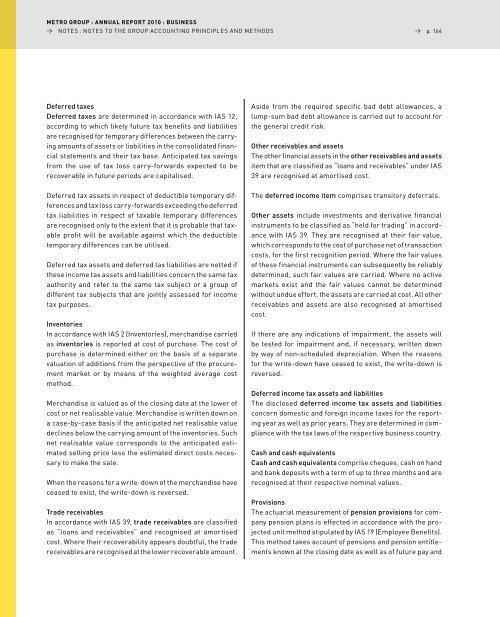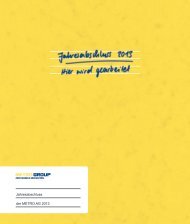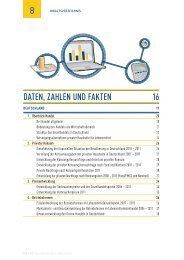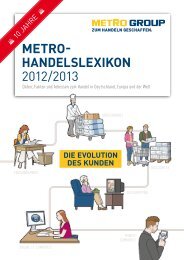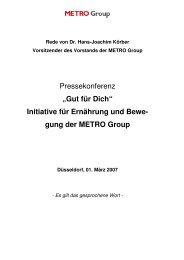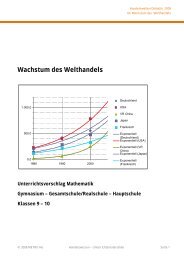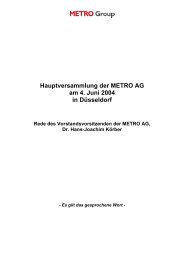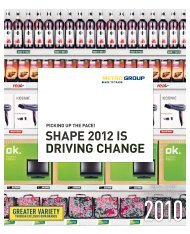pdf (2.5 MB) - METRO Group
pdf (2.5 MB) - METRO Group
pdf (2.5 MB) - METRO Group
Create successful ePaper yourself
Turn your PDF publications into a flip-book with our unique Google optimized e-Paper software.
<strong>METRO</strong> GROUP : ANNUAL REPORT 2010 : BUSINESS<br />
→ NOTES : NOTES TO ThE GROuP ACCOuNTING PRINCIPlES ANd METhOdS<br />
Deferred taxes<br />
Deferred taxes are determined in accordance with IAS 12,<br />
according to which likely future tax benefits and liabilities<br />
are recognised for temporary differences between the carrying<br />
amounts of assets or liabilities in the consolidated financial<br />
statements and their tax base. Anticipated tax savings<br />
from the use of tax loss carry-forwards expected to be<br />
recoverable in future periods are capitalised.<br />
deferred tax assets in respect of deductible temporary differences<br />
and tax loss carry-forwards exceeding the deferred<br />
tax liabilities in respect of taxable temporary differences<br />
are recognised only to the extent that it is probable that taxable<br />
profit will be available against which the deductible<br />
temporary differences can be utilised.<br />
deferred tax assets and deferred tax liabilities are netted if<br />
these income tax assets and liabilities concern the same tax<br />
authority and refer to the same tax subject or a group of<br />
different tax subjects that are jointly assessed for income<br />
tax purposes.<br />
Inventories<br />
In accordance with IAS 2 (Inventories), merchandise carried<br />
as inventories is reported at cost of purchase. The cost of<br />
purchase is determined either on the basis of a separate<br />
valuation of additions from the perspective of the procurement<br />
market or by means of the weighted average cost<br />
method.<br />
Merchandise is valued as of the closing date at the lower of<br />
cost or net realisable value. Merchandise is written down on<br />
a case-by-case basis if the anticipated net realisable value<br />
declines below the carrying amount of the inventories. Such<br />
net realisable value corresponds to the anticipated estimated<br />
selling price less the estimated direct costs necessary<br />
to make the sale.<br />
When the reasons for a write-down of the merchandise have<br />
ceased to exist, the write-down is reversed.<br />
Trade receivables<br />
In accordance with IAS 39, trade receivables are classified<br />
as “loans and receivables” and recognised at amortised<br />
cost. Where their recoverability appears doubtful, the trade<br />
receivables are recognised at the lower recoverable amount.<br />
→ p. 164<br />
Aside from the required specific bad debt allowances, a<br />
lump-sum bad debt allowance is carried out to account for<br />
the general credit risk.<br />
Other receivables and assets<br />
The other financial assets in the other receivables and assets<br />
item that are classified as “loans and receivables” under IAS<br />
39 are recognised at amortised cost.<br />
The deferred income item comprises transitory deferrals.<br />
Other assets include investments and derivative financial<br />
instruments to be classified as “held for trading” in accordance<br />
with IAS 39. They are recognised at their fair value,<br />
which corresponds to the cost of purchase net of transaction<br />
costs, for the first recognition period. Where the fair values<br />
of these financial instruments can subsequently be reliably<br />
determined, such fair values are carried. Where no active<br />
markets exist and the fair values cannot be determined<br />
without undue effort, the assets are carried at cost. All other<br />
receivables and assets are also recognised at amortised<br />
cost.<br />
If there are any indications of impairment, the assets will<br />
be tested for impairment and, if necessary, written down<br />
by way of non-scheduled depreciation. When the reasons<br />
for the write-down have ceased to exist, the write-down is<br />
reversed.<br />
Deferred income tax assets and liabilities<br />
The disclosed deferred income tax assets and liabilities<br />
concern domestic and foreign income taxes for the reporting<br />
year as well as prior years. They are determined in compliance<br />
with the tax laws of the respective business country.<br />
Cash and cash equivalents<br />
Cash and cash equivalents comprise cheques, cash on hand<br />
and bank deposits with a term of up to three months and are<br />
recognised at their respective nominal values.<br />
Provisions<br />
The actuarial measurement of pension provisions for company<br />
pension plans is effected in accordance with the projected<br />
unit method stipulated by IAS 19 (Employee Benefits).<br />
This method takes account of pensions and pension entitlements<br />
known at the closing date as well as of future pay and


